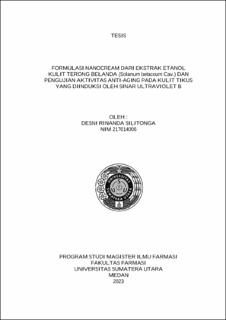| dc.description.abstract | Background: The skin is frequently exposed to ultraviolet B (UVB) rays, which can create free radicals and reactive oxygen species (ROS). The over time induction of Ultraviolet B (UVB) ray exposure can lead to oxidative stress, which ages the skin. Antioxidant components from the ethanol extract of Tamarillo peel (Solanum betacea Cav.) can be used to prevent this. Nanocream contains microscopic particles, it can improve the stability of the preparation and the rate at which active ingredients penetrate the skin.
Objective: To formulate nanocream and cream with ethanol extract of Tamarillo peel extract (EEKTB) which is induced by UVB light as anti-aging in mice.
Method: Determination of flavonoid levels, total phenolics, testing antioxidant activity and formulating into nanocream and cream dosage forms without extracts (NC0 and CR0), containing extracts of 0.5% (NC1 and CR1), 1.0% (NC2 and CR2) and 1.5% (NC3 and CR3), evaluating the physical characteristics of the preparation, physical stability for 12 weeks with temperature variations, rabbit skin irritation test and antiaging activity test on mouse skin compared with K(-) and K(+).
Results and Discussion: The total flavonoid and phenolic content of the EEKTB were obtained at 7.43 mgQE/g and 66.62 mgGAE/g with very strong antioxidant activity (IC50 = 47.95 ppm). The nanocream and cream formulas are stable and meet the evaluation requirements, except for the storage stability of the cream after 5, 6 and 7 weeks at high, room and low temperatures. The preparation did not irritate the skin of rabbits and the results of evaluation on the skin surface of CR0, K(-) mice experienced a change in texture to become rough in the 1st week and lesions began to form on the skin of K(-) in the 2nd week. Furthermore, the skin texture of the CR1 and NC0 mouse groups changed at week 2, the CR2 group at week 3, the CR3 and NC1 groups at week 4, K(+), NC2 and NC3 did not experience changes in skin texture. Microscopic observation of skin tissue in the NC3 group showed a thicker epidermis, denser collagen, a lower degree of inflammation, fewer fibroblasts and blood vessels compared to the other groups.
Conclusion: Nanocream extract is more stable and has better antiaging activity than cream preparations and the best antiaging activity is NC3 | en_US |


